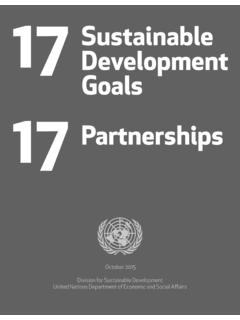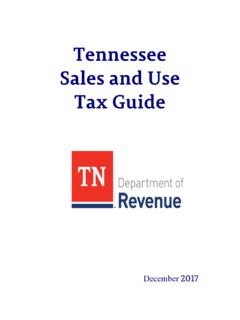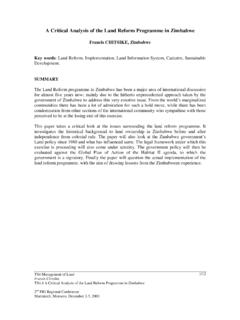Transcription of Extending the outreach of Rwandan Peoples’ Banks to the ...
1 Extending the outreach of Rwandan Peoples' Banks to the rural poor through village savings and credit associations*. By: Chet Aeschliman, Fiacre Murekezi and Jean-Paul Ndoshoboye AFRICA. RWANDA. Rwandan PEOPLES' BANK. July 2007. * This case study research, thanks to funding from the Ford Foundation, is a working document that is part of a multi-country review of successful innovations in improving access to financial services for poor populations in rural areas through linkages between the formal financial sector and informal financial institutions. The global review, coordinated by the rural Finance Group of the Food and Agriculture Organization (FAO) of the United Nations, examines 13 cases in Africa, Asia and Latin America.
2 Results from multi-country study will be published in a forthcoming book in early 2007. Acronyms BNR Banque Nationale du Rwanda BP Banque Populaire/People's Bank CARE Christian Action Research and Education CDC Comit de D veloppement Communautaire ECOCOMF Expanding Competitive Client-Oriented Microfinance FDC Fonds de D veloppement Communautaire IGA Income Generating Activities MoU Memorandum of Understanding MFI Microfinance Institution RESAFI R seau d'Epargne Sans Fronti re SCA Savings and Credit Associations COOPEC Savings and Credit Cooperatives UBPR Union of Peoples' Banks in Rwanda Extending the outreach of Rwandan Peoples' Banks to the rural poor through village savings and credit associations Abstract.
3 Over 65 percent of Rwanda's rural population are poor and their principal activity is farming. Despite having the physical capacity and even the professional skills needed to undertake successful economic activities, this population completely lacks investment capital. CARE International based in Rwanda is improving this situation through its CLASSE- Intambwe methodology, which involves mobilizing rural poor into savings and credit associations and linking them to the vast network of peoples' Banks that exist in the country. Although the linking' aspect is rather young beginning only in late 2003, initial results are encouraging. Today, all 1000 CARE supported savings and credit have savings accounts in their respective peoples' bank, and many group members have opened personal, individual accounts, thus bringing many into the financial mainstream.
4 This article explains the origins, mechanics and outcomes of this unique relationship. Introduction Over 65 per cent of Rwanda's rural population are poor and their principal activity is farming. Despite having the physical capacity and even the professional skills needed to undertake successful economic activities, this population completely lacks investment capital. CARE. International based in Rwanda is improving this situation through its CLASSE-Intambwe methodology, which involves mobilizing rural poor into savings and credit associations and linking them to the vast network of peoples' Banks that exist in the country. Although the linking' aspect is rather young beginning only in late 2003, initial results are encouraging.
5 Today, all 1,000 CARE supported savings and credit associations have savings accounts in their respective peoples' bank, and many group members have opened personal individual accounts, thus bringing many into the financial mainstream. This article explains the origins, mechanics and outcomes of this unique relationship. The setting The Republic of Rwanda is a small, impoverished and land-locked highland country in Central Africa. It is surrounded by the Democratic Republic of Congo, Burundi, Tanzania and Uganda. Its total area is 26,338 km2, of which 1,390 km2 is composed of water bodies. The country has an average altitude of about 2,750 M. Its main crops include beans, bananas and tea.
6 Its population in 2003 was estimated to be 8,128,553, with a population density of 321 inhabitants/km2, one of Africa's highest. The prevalence of HIV/AIDS increased substantially during the 1990s partly because of war and genocide, the most profound national event in the past decade, from per cent in rural areas in 1986 to per cent at present. Rwanda is now a trilingual country, where Kinrwanda is spoken by nearly everyone, with French being spoken mainly by the older generation, who were educated in pre- genocide Rwanda by its Belgian colonial masters and the national French-speaking school system following independence in 1962. English is spoken by those many Rwandans who grew up in exile in Uganda and returned after the genocide, thus explaining the mixture of French and English in this article.
7 Key players in Rwanda's financial sector Rwanda's financial system is composed of the central bank Banque Nationale du Rwanda (BNR), plus 6 commercial Banks , a network of 149 peoples' Banks (banques populaires, essentially credit unions), a few (the exact number is unknown) rival networks of savings and credit cooperatives ("COOPECs") and other multilateral financial institutions (MFIs), and a large number (perhaps thousands) of small savings and credit associations' (SCAs), essentially village Banks , with linkages to the peoples' Banks , the COOPECs, and sponsoring NGOs like CARE. The SCAs' linkage with the peoples' Banks is, in fact, the subject of this article.
8 National microfinance policies and strategies Since 1995, the period when banking activities resumed after the genocide, has been marked by reorganization of existing institutions that were decapitalized during the war. Because Rwanda's policy makers agreed that microfinance constitutes an important part of the country's poverty reduction and economic development strategies, several MFIs were set up. Their creation, which was a good idea, derives from the fact that Rwanda is in general a very poor country, especially in rural areas, and that the majority of Rwandans have low incomes and do not have access to the classic financial system. However, a problem of lack of professionalism in existing financial and microfinance institutions and inadequate supervision increases their risk of failure and loss of customers' deposits.
9 As of 2002, as previously indicated, in an attempt to improve MFIs' operations, the BNR issued directives regarding the microfinance sector. The new regulations were welcomed by all actors and stakeholders. However, the new regulations perhaps too hastily prepared create some major difficulties for small MFIs, such as: a requirement to pay US$9,300 into a frozen account when applying for registration; the difficult (for barely literate people) format and time frame required for submitting reports; and prudential ratios that are difficult to achieve (for example, the so-called creditworthiness' ratio: all MFIs must have equity capital equivalent to a minimum of 10 per cent of their assets).
10 As of 20 May 2005, a total of 206 MFIs had submitted applications to BNR to obtain registration (BNR, Banking Supervision Department). These included 148 peoples' Banks and 58. other MFIs, of which around 40 are part of the Rwanda Microfinance Forum (RMF), whose principal mission is to lobby for, and build the capacity of, its member institutions. Of the total 206 institutions, 112 peoples' Banks and 9 other institutions have been approved. There are other institutions that have yet to request approval from the BNR. These are often hard to detect, often setting themselves up spontaneously without feasibility studies or market surveys, lacking effective management and control tools, lacking supervisory and technical support systems, and hence have a high risk of failure and, in fact, often disappear just as suddenly as they appeared.




